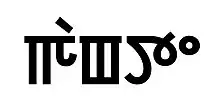Gangte people
Gangte is an ethnic group residing predominantly in the Indian state of Manipur, as well as in parts of Mizoram, Assam, and Myanmar. Identified as part of the larger Zo people, they are often categorized under the Kuki or Mizo tribes and are recognized as a tribe in both Manipur and under the Indian Constitution.[3] As of as of 2018, their global population is estimated to be approximately 40,000.[4] Their primary settlements in India are located in Churachandpur district of Manipur and in neighboring states, including Meghalaya, Mizoram, and Assam. The Gangtes predominantly use the Meitei language as their second language (L2).[5]
 The term "Gangte" written in Manipuri script (Meitei script) | |
| Total population | |
|---|---|
| 40,000 (approx) worldwide[1] | |
| Regions with significant populations | |
| Northeast India, Bangladesh, Burma | |
| Languages | |
| Gangte language (L1) Meitei language (L2)[2] | |
| Religion | |
| Christianity | |
| Related ethnic groups | |
| Meitei · Chin · Thadou · Hmar · Mizo · Simte · Vaiphei · Zou · Paite |
Naming System
The Gangtes utilize a distinct naming system designed to preserve their history and ancestry, especially given the absence of written historical records. Grandparents name their grandchildren using the last syllable of their own names—e.g., Thangmang leads to Manglun, which becomes Lunkholal, which turns into Lalminlun, etc. Grandfathers name grandsons and grandmothers name granddaughters. The firstborn son and daughter typically are named after the paternal grandparents, while the secondborn children are named after the maternal grandparents. This system is prevalent among many of the Zo peoples.
References
- "A-11 Individual Scheduled Tribe Primary Census Abstract Data and its Appendix". www.censusindia.gov.in. Office of the Registrar General & Census Commissioner, India. Retrieved 3 November 2017.
- "Meitei | Ethnologue". Ethnologue. Retrieved 3 May 2023.
- "List of notified Scheduled Tribes" (PDF). Census India. pp. 7–8. Archived from the original (PDF) on 7 November 2013. Retrieved 15 December 2013.
- Distribution of the 100 non-scheduled languages
- "Meitei". Ethnologue. Archived from the original on 24 July 2019. Retrieved 3 May 2023.
